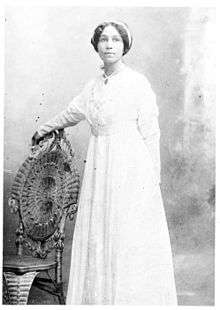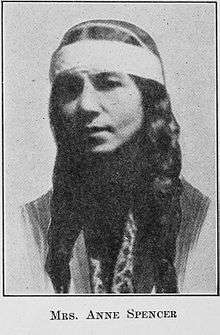Anne Spencer
| Anne Spencer | |
|---|---|
 Anne Bethel Spencer in her wedding dress, 1900 | |
| Born |
Annie Bethel Bannister February 6, 1882 Henry County, Virginia |
| Died |
July 27, 1975 (aged 93) Lynchburg, Virginia |
| Alma mater | Virginia Seminary |
| Genre | poetry |
| Literary movement | Harlem Renaissance |
The poet Anne Spencer was born Annie Bethel Bannister (February 6, 1882 – July 27, 1975) in Henry County, Virginia. A noted American poet, Anne Spencer was also a teacher, civil rights activist, librarian, and gardener. While a librarian at the all-black Dunbar High School, a position she held for 20 years, she supplemented the original three books by bringing others from her own collection at home. Though she lived outside New York City, the recognized center of the Harlem Renaissance, also known as the New Negro Movement, she was an important member of this group of intellectuals. Following her marriage to Edward Spencer in 1901, the couple moved to Lynchburg, Virginia where they raised a family and lived for the reminder of their lives.
As a poet, Spencer holds an important place as the first Virginian and first African American to have her poetry included in the highly influential Norton Anthology of American Poetry. As a civil rights activist for equality and educational opportunities, she and her husband Edward worked in association with James Weldon Johnson to develop a chapter of the NAACP in Lynchburg, Virginia, where their home became an important center and intellectual salon for Spencer's guests and dignitaries such as Langston Hughes, Marian Anderson, George Washington Carver, Thurgood Marshall, Dr. Martin Luther King Jr., James Weldon Johnson, and W. E. B. Du Bois. Anne Spencer also loved her garden and a cottage, Edankraal, which her husband Edward built for her in the garden behind their home. The name Edankraal combines Edward and Anne and kraal, the Afrikaans word for enclosure or corral.
Life
Childhood

Anne was born in Virginia to parents who were determined to make a better life for their daughter. The only child of Joel Cephus Bannister and Sarah Louise Scales, Anne Spencer was born Annie Bethel Bannister on February 6, 1882 in Henry County, Virginia, where her parents worked on a plantation after their marriage. Both parents, although her father Joel was born a slave in 1862, were part of the first generation of African Americans whose childhood followed the demise of slavery.
As an only child, Annie was the center of her parents' affections. This devotion led to their separation over differences in ideas about child rearing. After the separation, Annie Bannister was then known as Annie Scales, taking her mother's maiden name. Mother and daughter moved to West Virginia and settled in Bramwell, a town whose acceptance of African Americans and immigrants was unusual for the time. Annie lodged in the home of the Dixie family while her mother worked as a cook at a local inn. William T. Dixie, a proprietor of his own barber shop, his wife, Willie Belle, and their five children, were prominent members of the African American community.[1]
As a lodger in the Dixie household, Annie was without cares, chores, or schooling of any kind, even though she grew up with the Dixie children who attended school locally and routinely performed household chores. Sarah was deeply devoted to her daughter and she believed the local schools were unsuitable for her. Without the formal structure of education, Annie had an unusual amount of freedom for an African American child in the late nineteenth/early twentieth century. It was this freedom of life without care in Bramwell that would lead to her development as a poet, through her explorations of the natural world and her reliance on the solitude she found in the only private place available to her, the family outhouse. It was there in the outhouse, that Annie, as an illiterate child, would take the Sears and Roebuck catalog and seclude herself, turning the pages, imagining and dreaming herself as a reader.[2] Her childhood in Bramwell was to prove foundational to her development as a poet and an intellectual. The solitude she found in the Dixie's outhouse was to resurface for her as an adult in Lynchburg, with the garden house her husband built for her, called Edankraal, a name derived from the combination of their names, "Edward" and "Anne," and the Africaans word for enclosure or corral, "kraal."[3]
Although separated, Annie's parents, Joel and Sarah, continued contact concerning their daughter's well being. When Joel learned that Annie was not in school he sent Sarah an ultimatum that Annie must attend school or he would take her back to live with him. Although Sarah believed the local schools were unsuitable for Annie, she had learned of the Virginia Seminary at a church meeting. With Joel's ultimatum in mind, Annie was sent to Lynchburg to be enrolled in the Virginia Seminary in 1893 when she was 11 years old.[4] Despite her largely illiterate childhood, Annie excelled at the Virginia Seminary, delivering the valedictory address at her graduation in 1899.[4] Annie would return to Bramwell during breaks and over the summer. Having received a Normal School education at the Virginia Seminary, Annie returned to Bramwell after graduation and taught school in Elkhorn and Maybeury, West Virginia from 1899 - 1901.[5]
While at the Virginia Seminary Annie met fellow student Charles Edward Spencer, whom she married on May 15, 1901 at the Dixie's home in Bramwell. In 1903, the Spencers moved permanently to Lynchburg and built a home at 1313 Pierce Street where they raised three children together, two daughters, Bethel and Alroy, and a son, Chauncey Spencer. Chauncey was to continue his mother's legacy of activism, playing a prominent role in military service during World War II. Chauncey's actions and determination led to the formation of the Tuskegee Airmen. Chauncey Spencer was to become a noted member of that group at a time when African American pilots had been refused military service as pilots.[6]
Literary life

Anne Spencer's literary life began while she was a student at the Virginia Seminary where she wrote her first poem, "the Skeptic," now lost. She continued to write poetry throughout her life, using any scrap of paper or garden catalog page that was handy, to record her thoughts. While in the planning stages for opening a chapter of the NAACP in Lynchburg, Annie Spencer hosted James Weldon Johnson in her home, as a traveling representative for the NAACP. It was during this visit in 1919 that Johnson discovered Annie's poetry, and working through H.L. Mencken, Johnson's own editor, Annie had her first poem, "Before the Feast at Shushan," published in the February 1920 issue of The Crisis.She was 40 years old at the time her first poem was published. Johnson was also responsible for suggesting she use the more formal Anne Spencer, as her pen name.[3]
Legacy
Anne Spencer died at the age of 93 on July 27, 1975 and is buried alongside her husband Edward, who died in 1964, in the family plot at Forest Hills Cemetery in Lynchburg. In 2016, the Library of Virginia and Dominion Power honored her as one of their Strong Men and Women in Virginia History.[7]
The Lynchburg home in which Anne Spencer lived and worked is now a museum, the Anne Spencer House and Garden Museum. The Anne Spencer House and Garden Museum is dedicated to preserving her legacy and connection to the Harlem Renaissance.[8] A celebrated gardener during her lifetime, Anne's garden was inextricably woven into her life and provided the inspiration for much of her poetry. A garden house, the one-room retreat, called Edenkraal, where Anne did much of her writing, is also part of the property. Anne Spencer's papers, related family papers, and books from her personal library reside at the Albert and Shirley Small Special Collections Library at the University of Virginia. Some of Anne Spencer's personal correspondence with James Weldon Johnson, specifically selected by her, are part of the James Weldon Johnson Memorial Collection at the Beineke Rare Books and Manuscripts Library at Yale University.
Much of her poetry was deeply connected to her garden and she used her garden and the plants she grew there symbolically in many of her poems, among them, "Grapes, Still Life." Among her most influential works was "White Things", though it was not republished in her lifetime after its initial appearance in The Crisis. Nevertheless, its impact was such that Keith Clark, in Notable Black American Women, referred to it as "the quintessential 'protest' poem."[9] Still poetically active up to her death in 1975, Anne Spencer wrote one of her most evocative poems, titled for that same year, "1975."
Further reading
- Greene, J. Lee. Times Unfading Garden: Anne Spencer’s Life and Poetry. Louisiana State University Press. (1977).
- Afro-American Women Writers 1746-1933: An Anthology and Critical Guide (1989) Shockley, Ann Allen, New Haven, Connecticut: Meridian Books ISBN 0-452-00981-2
- With Head and Heart: The Autobiography of Howard Thurman, Thurman, Howard. Chicago:Harvest/HBJ Book, 1981. ISBN 0-15-697648-X
- Anne Spencer: Ah, how poets sing and die!, Spencer, Anne. Ed. Nina V. Salmon. Lynchburg: Warwick House Publishing, 2001
- Shadowed Dreams: Women's Poetry of the Harlem Renaissance, Rutgers; 2 Rev Exp edition (October 25, 2006). ISBN 0-8135-3886-6
- Marranca, Bonnie, editor. American Garden Writing: An Anthology. Expanded edition. Includes chapter on the restoration of Anne Spencer's garden. Lanham, MD.: Taylor Trade Pub., 2003.
- White, Jame Baber. Lessons learned from a Poet's Garden: The Restoration of the Historic Garden of Harlem Renaissance Poet Anne Spencer. Lynchburg, VA, Blackwell Press, 2011.
- Sacred Spaces: The Home of Anne Spencer. Introduction by poet Jeffrey Beam. Photos by John M. Hall. Captions provided by Anne's granddaughter Shaun Spencer-Hester and Jeffrey Beam in collaboration with Dr. J. Lee Greene, the biographer of Anne Spencer. The book accompanied an exhibit of Anne Spencer held at UNC-Chapel Hill February 2015 and are on exhibit through May 2015.
- Frischkorn, Rebecca T. and Reuben M. Rainey. Half my World: The Garden of Anne Spencer, a History and Guide. Lynchburg, Va: Warwick House, 2003.
- Packert, Beth, editor. Anne Spencer Revisited: A Companion to the Film by Keith Lee. Poems by Anne Spencer, edited and with notes by Beth Packert; illustrated with photographs by Susan Saandholland. Lynchburg, VA: Blackwell Press, 2008.
- Anne Spencer Revisited: A Film by Keith Lee. Dance Theatre of Lynchburg, 2008.
References
- ↑ Greene, J. Lee (1977). Times Unfading Garden: Anne Spencer's Life and Poetry. Louisiana State University Press. p. 12.
- ↑ Greene, J. Lee (1977). Times Unfading Garden: Anne Spencer's Life and Poetry. Louisiana State University Press. p. 15.
- 1 2 "Anne Spencer House and Garden Museum".
- 1 2 Greene, J. Lee (1977). Times Unfading Garden: Anne Spencer's Life and Poetry. Louisiana State University Press. p. 19.
- ↑ "Anne Spencer". e-WV Encyclopedia.
- ↑ "Memorial Day Tribute to Tuskegee Airmen: Chauncey Spencer". YouTube.
- ↑ http://www.lva.virginia.gov/public/smw/2016/honoree.htm?bio=spencer
- ↑ Higgins, Adrian (2015-07-28). "Where the Harlem Renaissance blossomed in Virginia, with poet Anne Spencer". Retrieved 2016-02-12.
- ↑ Contemporary Authors Online, Gale, 2009. Reproduced in Biography Resource Center. Farmington Hills, Mich.: Gale, 2009.
External links
- Entry at Modern American Poetry
- In Depth Informational Website at the Wayback Machine (archived October 2, 2007)
- Anne Spencer House and Garden,Lynchburg
- Works by or about Anne Spencer at Internet Archive
- Works by Anne Spencer at LibriVox (public domain audiobooks)

- Anne Spencer at Find a Grave
- Anne Spencer's Papers at the Albert and Shirley Small Special Collections Library